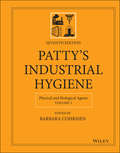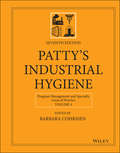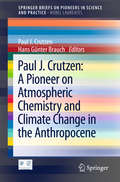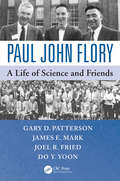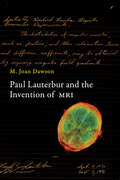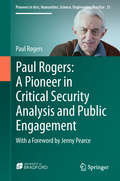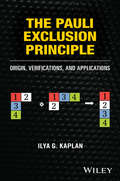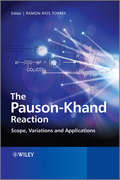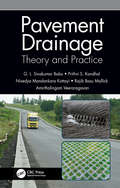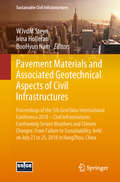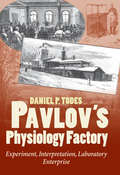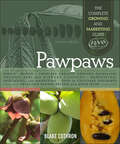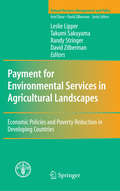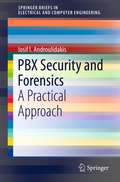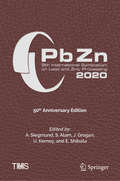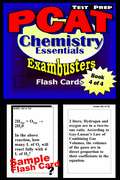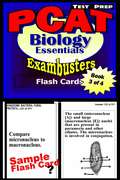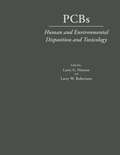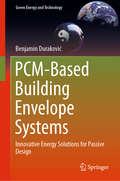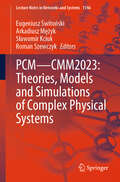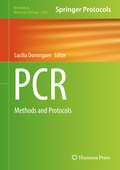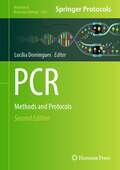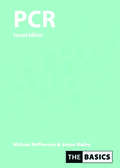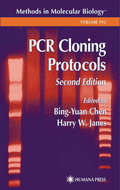- Table View
- List View
Patty's Industrial Hygiene, Physical and Biological Agents: 4 Volume Set
by Barbara CohrssenSince the first edition in 1948, Patty’s Industrial Hygiene and Toxicology has become a flagship publication for Wiley. During its nearly seven decades in print, it has become a standard reference for the fields of occupational health and toxicology. The volumes on industrial hygiene are cornerstone reference works for not only industrial hygienists but also chemists, engineers, toxicologists, lawyers, and occupational safety personnel. Volume 3 covers Recognition and Evaluation of Physical Agents and Biohazards. All of the chapters have been updated and a new chapter on Robotics has been added. These subjects are increasing in importance to industrial hygienists.
Patty's Industrial Hygiene, Program Management and Specialty Areas of Practice
by Barbara CohrssenSince the first edition in 1948, Patty’s Industrial Hygiene and Toxicology has become a flagship publication for Wiley. During its nearly seven decades in print, it has become a standard reference for the fields of occupational health and toxicology. The volumes on industrial hygiene are cornerstone reference works for not only industrial hygienists but also chemists, engineers, toxicologists, lawyers, and occupational safety personnel. Volume 4 covers environmental and health and safety program management, with a number of new chapters on sustainability, construction health and safety, health and safety of new energies and working with cannabis.
Paul J. Crutzen: A Pioneer on Atmospheric Chemistry and Climate Change in the Anthropocene
by Paul J. Crutzen Hans Günter BrauchThis book contains texts by the Nobel laureate Paul J. Crutzen who is best known for his research on ozone depletion. It comprises Crutzen's autobiography, several pictures documenting important stages of his life, and his most important scientific publications. The Dutch atmospheric chemist is one of the world's most cited scientists in geosciences. His political engagement makes him a tireless ambassador for environmental issues such as climate change. He popularized the term 'Anthropocene' for the current geological era acknowledging the enduring influence of humankind on planet Earth. This concept conceives humans to be a geologic factor, influencing the evolution of our globe and the living beings populating it. The selection of texts is representing Paul Crutzen´s scientific oeuvre as his research interests span from ozone depletion to the climatic impacts of biomass burning, the consequences of a worldwide atomic war - the Nuclear Winter - to geoengineering and the Anthropocene.
Paul John Flory: A Life of Science and Friends
by Gary D. Patterson James E. Mark Joel Fried Do YoonPaul John Flory: A Life of Science and Friends is the first full-length treatment of the life and work of Paul John Flory, recipient of the Nobel Prize in chemistry in 1974. It presents a chronological progression of his scientific, professional, and personal achievements as recounted and written by his former students and colleagues.This book cove
Paul Lauterbur and the Invention of MRI
by M. Joan DawsonThe story behind the invention of the most important medical diagnostic tool since the X-ray.On September 2, 1971, the chemist Paul Lauterbur had an idea that would change the practice of medical research. Considering recent research findings about the use of nuclear magnetic resonance (NMR) signals to detect tumors in tissue samples, Lauterbur realized that the information from NMR signals could be recovered in the form of images—and thus obtained noninvasively from a living subject. It was an unexpected epiphany: he was eating a hamburger at the time. Lauterbur rushed out to buy a notebook in which to work out his idea; he completed his notes a few days later. He had discovered the basic method used in all MRI scanners around the world, and for this discovery he would share the Nobel Prize for Physiology or Medicine in 2003. This book, by Lauterbur's wife and scientific partner, M. Joan Dawson, is the story of Paul Lauterbur's discovery and the subsequent development of the most important medical diagnostic tool since the X-ray.With MRI, Lauterbur had discovered an entirely new principle of imaging. Dawson explains the science behind the discovery and describes Lauterbur's development of the idea, his steadfastness in the face of widespread skepticism and criticism, and related work by other scientists including Peter Mansfield (Lauterbur's Nobel co-recipient), and Raymond Damadian (who famously feuded with Lauterbur over credit for the ideas behind MRI). She offers not only the story of one man's passion for his work but also a case study of how science is actually done: a flash of insight followed by years of painstaking work.
Paul Rogers: With a Foreword by Jenny Pearce (Pioneers in Arts, Humanities, Science, Engineering, Practice #21)
by Paul RogersThis book brings together a collection of writings over the past half century from Professor Paul Rogers. As a leading peace researcher he has gained an international reputation for the critical, independent and rigorous analysis of international security and the underlying causes of global conflict. His work on the responses to 9/11 and the continuing failure of the war on terror, in particular, has shown prescience that has attracted widespread attention. Moreover, he has coupled his academic analysis with a determination to communicate widely beyond the university environment. With many thousands of radio and television interviews, hundreds of public lectures and a world-wide following for his web publishing, this extramural engagement consistently seeks to raise the level of public debate on international security issues.- Provides a radically different perspective on global security, based on 50 years of analysis- Uniquely integrates economic, environmental and security analysis into a single overview- Cogently demonstrates the urgent need to rethink our entire approach to global security
The Pauli Exclusion Principle: Origin, Verifications, and Applications
by Ilya G. KaplanThis is the first scientic book devoted to the Pauli exclusion principle, which is a fundamental principle of quantum mechanics and is permanently applied in chemistry, physics, and molecular biology. However, while the principle has been studied for more than 90 years, rigorous theoretical foundations still have not been established and many unsolved problems remain. Following a historical survey in Chapter 1, the book discusses the still unresolved questions around this fundamental principle. For instance, why, according to the Pauli exclusion principle, are only symmetric and antisymmetric permutation symmetries for identical particles realized, while the Schrödinger equation is satisfied by functions with any permutation symmetry? Chapter 3 covers possible answers to this question. The construction of function with a given permutation symmetry is described in the previous Chapter 2, while Chapter 4 presents effective and elegant methods for finding the Pauli-allowed states in atomic, molecular, and nuclear spectroscopy. Chapter 5 discusses parastatistics and fractional statistics, demonstrating that the quasiparticles in a periodical lattice, including excitons and magnons, are obeying modified parafermi statistics. With detailed appendices, The Pauli Exclusion Principle: Origin, Verifications, and Applications is intended as a self-sufficient guide for graduate students and academic researchers in the fields of chemistry, physics, molecular biology and applied mathematics. It will be a valuable resource for any reader interested in the foundations of quantum mechanics and its applications, including areas such as atomic and molecular spectroscopy, spintronics, theoretical chemistry, and applied fields of quantum information.
Paulo's Parachute Mission
by Engineering is Elementary TeamPaulo is not happy about his family's move to Alcantara, Brazil to be close to its space launch pad. <P><P>While Paulo's parents, both aerospace engineers, are excited about the design projects in their new jobs, Paulo is worried about leaving his friends behind and meeting new people. The last thing he wants to do is make friends with his new neighbor, Lucas.
The Pauson-Khand Reaction
by Ramon Rios TorresThe Pauson-Khand reaction is an important reaction in the field of organic chemistry. It involves the transition-metal catalysed cycloaddition of an alkyne, an alkene and carbon monoxide, to produce cyclopentenones. The importance of this reaction originates from its high value in transforming simple components into the synthetically useful cyclopentenone unit, in which a high degree of molecular complexity can be achieved in a single step, with impressive stereochemical and regiochemical control.The Pauson-Khand Reaction investigates the nature and many variations of this reaction.Topics covered include: the mechanisms of Pauson-Khand-type reactionsnon chiral intramolecular and intermolecular versions of Pauson-Khand reactionsasymmetric Pauson-Khand reaction using chiral auxiliariesthe enantioselective Pauson-Khand reactionPauson-Khand reactions catalysed by metals other than cobaltunconventional Pauson-Khand reactionsthe Pauson-Khand reaction in total synthesisPresenting a comprehensive overview of this fundamental reaction, The Pauson-Khand Reaction will find a place on the bookshelves of any organic or organometallic chemist.
Pavement Drainage: Theory and Practice
by G L Babu Prithvi S. Kandhal Nivedya Mandankara Kottayi Rajib Basu Mallick Amirthalingam VeeraragavanSUMMARY This book provides complete coverage of surface and subsurface drainage of all types of pavements for highways, urban roads, parking lots, airports, and container terminals. It provides up-to-date information on the principles and technologies for designing and building drainage systems and examines numerous issues, including maintenance and designing for flood events. Practical considerations and sophisticated analysis, such the use of the finite element method and unsaturated soil mechanics, anisotropy and uncertainties, are presented. This book allows civil engineers to make the best use of their resources to provide cost effective and sustainable pavements. Features Presents a holistic consideration of drainage with respect to pavement performance. Includes numerous practical case studies. Examines flooding and the impacts of climate change. Includes PowerPoint slides which include quizzes, schematics, figures, and tables.
Pavement Materials and Associated Geotechnical Aspects of Civil Infrastructures: Proceedings of the 5th GeoChina International Conference 2018 – Civil Infrastructures Confronting Severe Weathers and Climate Changes: From Failure to Sustainability, held on July 23 to 25, 2018 in HangZhou, China (Sustainable Civil Infrastructures)
by WJvdM Steyn Irina Holleran BooHyun NamThis book contains latest research studies regarding issues related to civil infrastructure such as pavement layers and material properties. It contains research data and conclusions that should lead to more resilient infrastructure design, maintenance and management. Civil engineering researchers and practitioners will gain valuable information from this material. Papers were selected from the 5th GeoChina International Conference on Civil Infrastructures Confronting Severe Weathers and Climate Changes: From Failure to Sustainability, held on July 23-25, 2018 in HangZhou, China.
Pavlov's Physiology Factory: Experiment, Interpretation, Laboratory Enterprise
by Daniel P. TodesRussian physiologist and Nobel Prize winner Ivan Pavlov is most famous for his development of the concept of the conditional reflex and the classic experiment in which he trained a dog to salivate at the sound of a bell. In Pavlov's Physiology Factory: Experiment, Interpretation, Laboratory Enterprise, Daniel P. Todes explores Pavlov's early work in digestive physiology through the structures and practices of his landmark laboratory—the physiology department of the Imperial Institute for Experimental Medicine. In Lectures on the Work of the Main Digestive Glands, for which Pavlov won the Nobel Prize in 1904, the scientist frequently referred to the experiments of his coworkers and stated that his conclusions reflected "the deed of the entire laboratory." This novel claim caused the prize committee some consternation. Was he alone deserving of the prize? Examining the fascinating content of Pavlov's scientific notes and correspondence, unpublished memoirs, and laboratory publications, Pavlov's Physiology Factory explores the importance of Pavlov's directorship of what the author calls a "physiology factory" and illuminates its relationship to Pavlov's Nobel Prize-winning work and the research on conditional reflexes that followed it.Todes looks at Pavlov's performance in his various roles as laboratory manager, experimentalist, entrepreneur, and scientific visionary. He discusses changes wrought by government and commercial interests in science and sheds light on the pathways of scientific development in Russia—making clear Pavlov's personal achievements while also examining his style of laboratory management. Pavlov's Physiology Factory thus addresses issues of importance to historians of science and scientists today: "big" versus "small" science, the dynamics of experiment and interpretation, and the development of research cultures.
Pawpaws: The Complete Growing and Marketing Guide
by Blake Cothron“With this valuable book, you can pawpaw your own food forests, restoring the diversity, abundance, and climate we all need.” —Albert Bates, permaculture instructor, ecovillage designer, author of The Biochar SolutionPawpaws is the first in-depth guide to small-scale commercial cultivation of pawpaws. Also known as Indiana bananas or hipster bananas, this almost forgotten fruit, native to North America, is making a huge comeback with foodies, chefs, craft brewers, and discerning fruit-lovers.Written by, and for, the organic grower, coverage includes:Botany and the cultural history of pawpawsOrchard siting and planningChoosing the best-quality nursery treesDescriptions of over fifty cultivarsPropagation and organic growing tipsPests and disease managementMarketing and selling fresh pawpaws, seeds, and startsProcessing and producing value-added products.Get ahead of the farming curve, diversify your orchard or food forest, and discover the commercial potential of America’s almost forgotten native fruit with this comprehensive manual to small-scale commercial pawpaw production.“Blake Cothron is an authority on pawpaws and provides a clear, detailed guide for commercial success in growing this ‘oddly appealing species’ (his own words). The supply of this exotic, trending, easy-to-grow fruit has not yet met the demand. Blake shares the wealth of his knowledge, including challenges—and when he doesn’t know, he says so (it’s probable that others don’t know either).” —Pam Dawling, author of Sustainable Market Farming“The pawpaw’s revival is long overdue. Blake Cothron’s Pawpaws will help bring about the day when fragrant fruit is no longer a rare treat, but a regular part of our seasonal diet.” —Darrell E. Frey, Three Sisters Farm, author of Bioshelter Market Garden
Payment for Environmental Services in Agricultural Landscapes
by David Zilberman Takumi Sakuyama Leslie Lipper Randy StringerIn recent years, development policy has responded to an increasing concern about natural resource degradation by setting up innovative payment for environmental services (PES) programs in developing countries. PES programs use market and institutional incentives in order to meet both environmental and poverty alleviation objectives. However, their optimal design, implications for the rural poor, and how these initiatives integrate into international treaties on global warming and biodiversity loss are still being discussed. This book addresses these issues by scrutinizing analytical tools, providing policy insights and stimulating debate on linkages between poverty alleviation and environmental protection. In particular, it turns attention towards the role of environmental services in agricultural landscapes as they provide a living for many poor in developing countries. It serves as a valuable reference for academics and students in various disciplines, as well as for policy makers and advisors. This book is a co-publication between Springer and the Food and Agriculture Organization of the United Nations.
PBX Security and Forensics
by I. I. AndroulidakisPBX Security and Forensics presents readers with theoretical and practical background for Private Branch Exchanges (PBXs). PBX is privately owned equipment that serve the communication needs of a private or public entity making connections among internal telephones and linking them to other users in the Public Switched Telephone Network (PSTN). Targeted damages and attacks in PBXs can cause significant instability and problems. The author provides examples of these threats and how to prevent against such attacks in the future. Readers will also be shown where to find forensics data and how to conduct relevant analysis.
PbZn 2020: 9th International Symposium on Lead and Zinc Processing (The Minerals, Metals & Materials Series)
by J. Grogan A. Siegmund S. Alam U. Kerney E. ShibataEstablished in 1970, the PbZn symposium series is considered the leading international technical forum for the lead and zinc processing industries. The PbZn 2020 volume addresses all aspects of current processing technologies for primary and secondary lead and zinc, as well as emerging technologies for both metals.
PCAT Test Prep Flash Cards: Chemistry Essentials (Exambusters PCAT Workbook #4 of 4)
by Ace Inc.<P><P><i>Advisory: Bookshare has learned that this book offers only partial accessibility. We have kept it in the collection because it is useful for some of our members. Benetech is actively working on projects to improve accessibility issues such as these.</i><P><P> 700 questions and answers. Essential definitions, formulas, concepts, and sample problems. <P><P>Topics: Introduction, Matter, Atoms, Formulas, Moles, Reactions, Elements, Periodic Table, Electrons, Chemical Bonds, Heat, Gases, Phase Changes, Solutions, Reaction Rates, Equilibrium, Acids and Bases, Oxidation and Reduction, Introduction to Organic Chemistry, Radioactivity <P>Exambusters PCAT Prep Workbooks provide comprehensive, fundamental PCAT review--one fact at a time--to prepare students to take practice PCAT tests. Each PCAT study guide focuses on one specific subject area covered on the PCAT exams. From 300 to 600 questions and answers, each volume in the PCAT series is a quick and easy, focused read. Reviewing PCAT flash cards is the first step toward more confident PCAT preparation and ultimately, higher PCAT exam scores!
PCAT Test Prep Flash Cards: Biology Essentials (Exambusters PCAT Workbook #3)
by Ace Inc.<P><P><i>Advisory: Bookshare has learned that this book offers only partial accessibility. We have kept it in the collection because it is useful for some of our members. Benetech is actively working on projects to improve accessibility issues such as these.</i><P><P> 450 questions and answers (ILLUSTRATED). Essential definitions and concepts. <P><P>Topics: Cells, Biochemistry and Energy, Evolution and Classification, Kingdoms: Bacteria, Fungi, Protista; Kingdom: Plantae, Kingdom: Animalia, Human Locomotion, Human Circulation and Immunology, Human Respiration and Excretion, Human Digestion, Human Nervous System, Human Endocrinology, Reproduction and Development, Genetics, Ecology <P>Exambusters PCAT Prep Workbooks provide comprehensive, fundamental PCAT review--one fact at a time--to prepare students to take practice PCAT tests. Each PCAT study guide focuses on one specific subject area covered on the PCAT exams. From 300 to 600 questions and answers, each volume in the PCAT series is a quick and easy, focused read. Reviewing PCAT flash cards is the first step toward more confident PCAT preparation and ultimately, higher PCAT exam scores!
PCBs: Human and Environmental Disposition and Toxicology
by Paul S Cooke Takeshi Nakano Tomas Tmovec Deborah C Rice Linda S Birnbaum Charles S WongThough polychlorinated biphenyls (PCBs) have been banned in the United States for more than thirty years, the toxic effects of their presence in local environments continue to be a significant public health concern. PCBs: Human and Environmental Disposition and Toxicology brings together more than fifty established specialists on PCB toxicity to discuss recent trends and specialized investigations of PCB influences on the environment and on humans. Renowned scientists including Paul S. Cooke, Takeshi Nakano, Tomas Trnovec, Deborah C. Rice, Linda S. Birnbaum, and Charles S. Wong present cutting-edge research on Hudson River PCBs, human contamination, homologue profiles, high PCB exposure in Slovakia, and PCB effects on the thyroid hormone, nutrition, and estrogen levels in humans and animals. Focusing on the detection, movement, metabolism, toxicity, remediation, and risk assessment of PCB contamination, this multi-disciplinary study is a valuable resource for regulatory agencies and scientists working with PCBs.
PCM-Based Building Envelope Systems: Innovative Energy Solutions for Passive Design (Green Energy and Technology)
by Benjamin DurakovićPCM Enhanced Building Envelopes presents the latest research in the field of thermal energy storage technologies that can be applied to solar heating and cooling with the aim of shifting and reducing building energy demand. It discusses both practical and technical issues, as well as the advantages of using common phase change materials (PCMs) in buildings as a more efficient, novel solution for passive solar heating/cooling strategies. The book includes qualitative and quantitative descriptions of the science, technology and practices of PCM-based building envelopes, and reflects recent trends by placing emphasis on energy storage solutions within building walls, floors, ceilings, façades, windows, and shading devices. With the aim of assessing buildings’ energy performance, the book provides advanced modeling and simulation tools as a theoretical basis for the analysis of PCM-based building envelopes in terms of heat storage and transfer. This book will be of interest to all those dealing with building energy analysis such as researchers, academics, students and professionals in the fields of mechanical and civil engineering and architectural design
PCM—CMM2023: Theories, Models and Simulations of Complex Physical Systems (Lecture Notes in Networks and Systems #1146)
by Eugeniusz Świtoński Arkadiusz Mężyk Sławomir Kciuk Roman SzewczykThe idea of organizing the Polish Congress of Mechanics was born in 2005 among members of the Polish Society of Theoretical and Applied Mechanics. The first Congress has been organized in 2007. In 2013, the organization of the Polish Congress of Mechanics was included in the statutory tasks of the Polish Society of Theoretical and Applied Mechanics. Referring to the splendid tradition of Polish Theoretical and Applied Mechanics, the Congress has become one of the most important international scientific conventions representing this domain of science and gathering every 4 years about 500–600 specialists, who deal with the issues of mechanics and mechanical engineering in a broad sense. The organization of the Congress allows for the connection of many scientific communities, researchers, and engineers from various universities, faculties, research centers, and institutions. Such scientific meeting is an excellent place for presentation, discussion, and dissemination of new achievements and ideas relating to the theoretical foundations as well as practical applications of mechanics. The Congress presents the current state-of-the-art research in all disciplines of classical and quantum mechanics, solid and fluid mechanics, computational mechanics, applied mechanics, and physics, as well as structural mechanics and engineering.
Pcr: Methods and Protocols (Methods in Molecular Biology #1620)
by Lucília DominguesThis volume details PCR technique with focus on its application specificities to the biotechnology and bioengineering field. Chapters are broken into five sections covering sgeneral PCR protocols, different applied examples to molecular and synthetic biotechnology, food science and technology, environmental microbiology and molecular ecology, and healthcare. Written in the highly successful Methods in Molecular Biology series format, chapters include introductions to their respective topics, lists of the necessary materials and reagents, step-by-step, readily reproducible laboratory protocols, and tips on troubleshooting and avoiding known pitfalls.Authoritative and cutting-edge, PCR: Methods and Protocols hopes to be a valuable and useful resource for wet lab researchers, particularly within the biotechnology and bioengineering field.
PCR: Methods and Protocols (Methods in Molecular Biology #2967)
by Lucília DominguesThis second volume focuses on PCR methods and PCR application specificities to the biotechnology and bioengineering field. New and updated chapters detail real-time PCR protocols, synthetic biology applications, pathogen detection, microfluidics, digital, multiplex detection recent advances. Written in the highly successful Methods in Molecular Biology series format, chapters include introductions to their respective topics, lists of the necessary materials and reagents, step-by-step, readily reproducible laboratory protocols, and key tips on troubleshooting and avoiding known pitfalls. Authoritative and cutting-edge, PCR: Methods and Protocols, Second Edition aims to be a useful and practical guide to new researchers and experts looking to expand their knowledge.
PCR
by Mike McPherson Simon MøllerA thoroughly updated version of the successful first edition with a new chapter on Real-Time PCR, more prokaryotic applications, and more detail in the complex mutagenesis sections. Information on PCR applications in genomics and proteomics have been expanded and integrated throughout the text. There is also advice on available products a
PCR Cloning Protocols
by Harry W. Janes Bing-Yuan ChenPCR Cloning Protocols, Second Edition, updates and expands Bruce White's best-selling PCR Cloning Protocols (1997) with the newest procedures for DNA cloning and mutagenesis. Here the researcher will find readily reproducible methods for all the major aspects of PCR use, including PCR optimization, computer programs for PCR primer design and analysis, and novel variations for cloning genes of special characteristics or origin, with emphasis on long distance PCR and GC-rich template amplification. Also included are both conventional and novel enzyme-free and restriction site-free procedures to clone PCR products into a range of vectors, as well as state-of-the-art protocols to facilitate DNA mutagenesis and recombination, and to clone the challenging uncharacterized DNA flanking a known DNA fragment.
